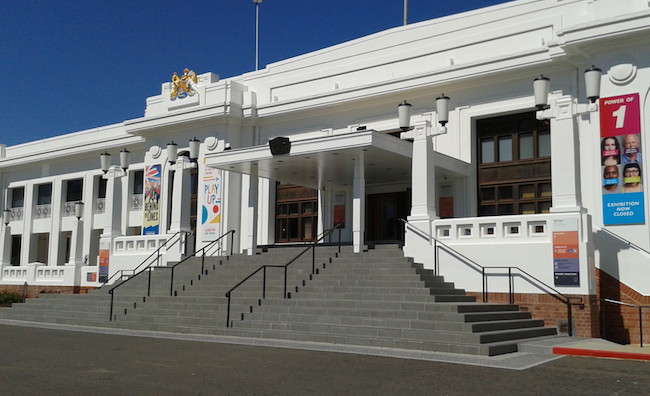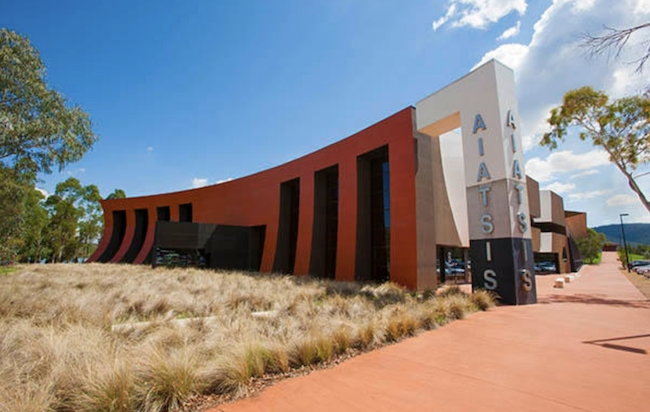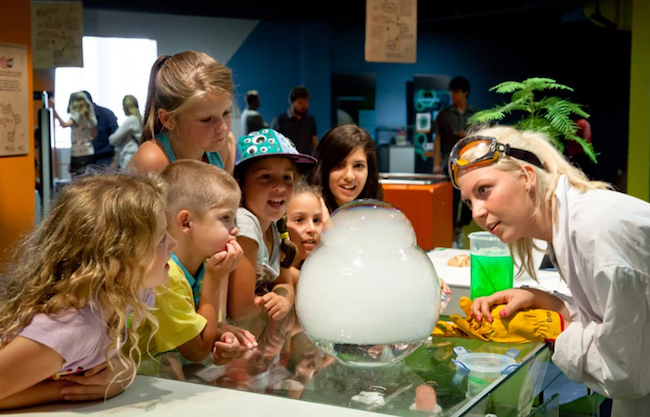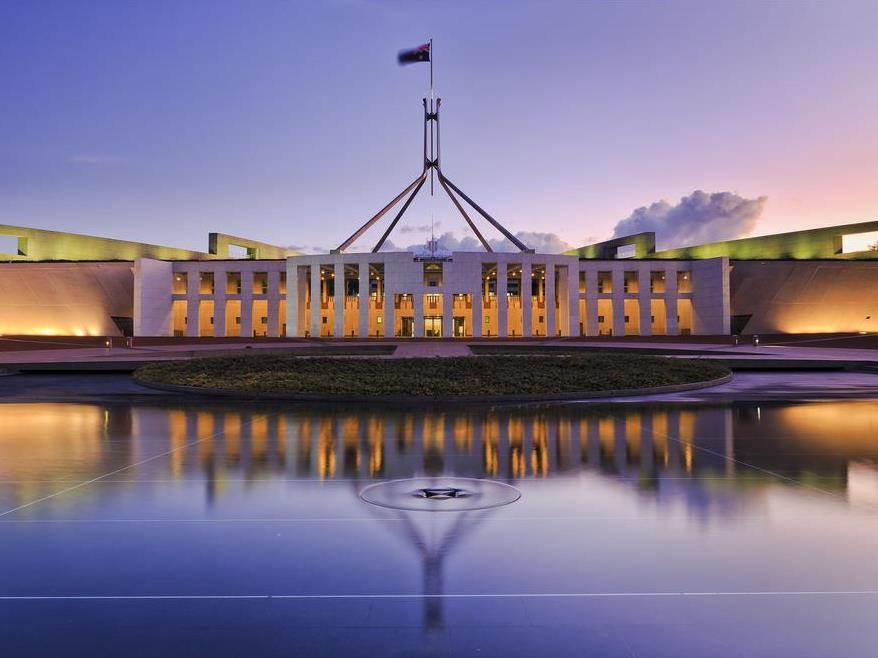Parliament House. Image via Shutterstock.
In the wake of the 2019 Budget, one could be forgiven for missing the news that the long awaited report, Telling Australia’s story – and why it’s important: Report on the inquiry into Canberra’s national institution was tabled the following day in Parliament (3 April).
The Committee’s inquiry examined a range of institutions, from those that are internationally recognised, such as the Australian War Memorial (AWM), National Gallery of Australia (NGA), National Library of Australia (NLA) and National Portrait Gallery (NPG), to those with a lower profile such as the Australian Institute of Aboriginal and Torres Strait Islander Studies (AIATSIS), National Archives of Australia and National Electoral Education Centre (NEEC).
Also included in the inquiry were the National Museum of Australia (NMA), National Film and Sound Archive of Australia (NFSA), National Botanic Gardens, Questacon, the CSIRO Discovery Centre, High Court of Australia and Australian Institute of Sport.
Some of these barely hit the Report’s radar, perhaps raising questions of the holistic nature of its recommendations.
In all, a total of 16 institutions were put under the bureaucratic microscope. And, regardless of scale, the message of the Report was consistent: ‘The Committee was concerned that our institutions are not working together to communicate the shared importance of their telling of our national story.’
The report continued: ‘They should understand themselves not as a set of separate and competing entities, but as a cohesive whole, with the core objective of connecting Australians to their national story.’
In other words, the Inquiry found that our national institutions, whose remit was described as ‘to preserve and promote Australia’s history, culture, arts, science and democracy,’ weren’t doing their job well enough.
While some celebrated the Report’s findings, it goes without saying that it was not received well by many Canberra institutions – and their views were supported more broadly across the sector. Feedback suggests the Report was unnecessarily harsh towards some institutions and lacked a thorough discussion of what was needed to bolster a local sector that has suffered so harshly from cuts and efficiency measures in recent years.
Esther Anatolitis, CEO NAVA tweeted on the Report: ‘Among great insights from the institutions are concerning recommendations that don’t seem to have listened to – like co-marketing/branding, and review of functions rather than adequate funding.’
The Report singled out the decade-old Museum of Australian Democracy (MoAD) at Old Parliament House, claiming that it has ‘crept from its core focus and role’ and is in need of review.
The wins, however were clear: to relocate AIATSIS to an expanded new home in the Parliamentary Zone (could the committee have its eye on MoAD?); a business case for a new natural history museum; an urgent need for institutions to digitise their analogue audio-visual items before it is too late; a review of the Parliament and Civics Education Rebate (PACER) program for school visits and a redressing of the efficiency measures that so harshly hit some institutions.
The Committee received 83 submissions and 14 supplementary submissions, and held five public hearings in Canberra between June and December 2018. It handed down 20 recommendations.
ArtsHub offers a FACT CHECK on what the real impact and implications of those recommendations are.
Recommendation 1: That the national institutions develop and articulate a shared narrative.
Not Constructive: The Report stated that the primary role of Canberra’s national institutions was ‘to preserve and promote Australia’s history, culture, arts, science and democracy.’
While that sounds great in a Report that’s trying to consolidate a sector, there is incredible breadth in each of those specialisations that makes it difficult to roll out ‘a shared narrative’.
Alex Marsden, National Director, Australia Museums and Galleries Association (AMGA), commented on the recommendation: ‘The NCIs collaborate in many ways – in research, shared administrative services, and in shared storage. For example, Questacon is collaborating with CSIRO’s Data 61 on gamification of research in biodiversity and Australian stories, and the National Museum of Australia has led the shared services agenda. However, there could be greater collaboration, and support for that would be very welcome.’
Recommendation 2: That the national institutions make a stronger concerted effort to undertake collective branding and marketing.
Fair: Given the scale of the Canberra arts and culture community, it is a no-brainer that collective efforts should aim to draw non-local audiences to visit national assets through better branding and aggregated marketing.
A good example is the recently formed consortium of 27 cultural organisations across Sydney that have come together to increase visibility and accelerate innovative partnerships.
Read: A global first for Sydney cultural organisations
In a recent ArtsHub interview with Karen Quinlan, the National Portrait Gallery’s new Director, she commented: ‘There is great opportunity here in Canberra for the cultural institutions to work together – all of us at the table – and that is something I really want to pursue, especially to deepen our relationship with our neighbours the National Gallery and the Library. Strength in numbers in such in a small place is a win-win.’
The Committee reported that ‘In 2017, Canberra had a record breaking 2.75 million domestic overnight visitors and 243 000 international visitors,’ but makes the point that, ‘Canberra’s national institutions struggled to take the further step of articulating clearly how their work provided a direct benefit to the people of Australia, beyond the metrics of visitor numbers and economic gains.’
It continued: ‘While the Committee welcomes the fact that visitor numbers to many institutions are increasing, it is concerned by evidence suggesting that some national institutions may not be collecting and analysing enough data on their visitors to ensure that their offerings are appropriate, targeted and promote growth.’
Articulating qualitative value is not exclusive to Canberra national institutions, and is perhaps one of the most pressing agendas that the arts and culture sector faces in combating such inquiries and reports.
The Committee also reported that ‘currently, 22 attractions participate in the National Capital Educational Tourism Project (NCETP) cooperative marketing program, including some national institutions such as the Australian National Botanic Gardens, the CSIRO Discovery Centre, the National Archives of Australia and the High Court of Australia’. The NCETP argued, however, that ‘departmental constraints and fluctuations in funding’ have affected the ability of some of the national institutions to join the Project.’
It offered no solution to those funding fluctuations to marketing constraints.
Recommendation 3: To encourage new migrants to visit Canberra’s national institutions.
Laudable but loose: While this is a laudable goal, the Report offers little scope as to how that might be implement, including pathways and financial assistance to mount such a broad objective. Such an initiative would potentially require new public programming, educator training, language assistance, and travel subsidies.
Recommendation 4: The report recommends that the Department of Education and Training undertake a comprehensive review of the PACER program.
A win: The committee reported that more than 165,000 school students visit Canberra’s national institutions each year, and more than half of these do so with the help of funding provided by the Government’s Parliament and Civics Education Rebate (PACER) program
It heard that some school programs had waiting lists of up to two years, with disproportionate support to schools from Australia’s east coast.
The Committee recommended a review addressing increasing demand, criteria for prioritising applications and funding, and the program’s governance.
Recommendation 5: That national institutions develop a program to encourage and promote engagement in science education by school students visiting Canberra.
Laudable but loose: While STEAM is a trending conversation, it is a topic caught more in talk than action. The Report continued that necessary conversation without really addressing it.
Recommendation 6: That the Australian Government review the objectives, roles and functions of the MoAD, the National Electoral Education Centre and the visitor and education services at Parliament House; and consider the merits of their closer administrative and operational alignment.
Constructive, but loaded: The report was deeply critical of MoAD, so while this is potentially an audit of efficiency measures and making it more accountable to the public sector for a better use of funds and resources, it feels like a compression of resources is on the horizon.
Recommendation 7: To expand the facilities and resourcing of the Parliamentary Education Office and the National Electoral Education Centre, to allow them to offer regular programs to public visitors as well as school groups.
Fair: As with recommendation 6, overlap needs to be assessed and a potential pooling of resources considered. Allowing these organisations to open to the public will require programming and visitor services staffing, which the report fails to address in terms of assigned funding.

Museum of Australian Democracy, Canberra; shutterstock
Recommendation 8: To examine the present objectives and activities of MoAD, focussing on its core responsibilities, given its 10th anniversary in 2019.
Belly punch: The report notes that the MoAD anniversary offers a timely moment to assess its focus and effectiveness. It states: ‘The Committee has concerns about the disconnect between MoAD’s fundamental strategic role, and the direction of some of its engagement with the public … Its current and emerging focus on critical debates and discourse about democracy is best left to academics, think tanks or media analysis.’
Alex Marsden commented on the recommendation: ‘There is a lot to investigate in any such proposal – however it would be counter-productive to downgrade any of the soundly museologically-based approaches by MOAD which are stimulating critical thinking and a nuanced understanding of democracy, history and citizenship.’
The committee believes that MoAD should ‘improve its focus on developing visitors’ understanding of our nation’s democratic history’.
Recommendation 9: To create centres for each political party, located at MoAD, to collect, preserve, research and make available publications and exhibitions on the parties’ history, campaigns, policies and achievements.
Confused: Sounds like propaganda, or is this how the government best views MoAD’s role?
Recommendation 10: That during the 2019-2020 financial year the Australian National Audit Office conduct a follow-up audit of Canberra’s National Collecting Institutions, monitoring their implementation of recommendations made in ANAO’s 2005 and 2018 reports.
A win: The 2005 and 2018 reports found issues with institutions’ governance, risk management and records management relating to the national collection. Many institutions have worked very hard in the subsequent years to address these concerns.
A further audit would be welcomed to assess and identify the financial need to complete previous recommendations.
Recommendation 11: That collectively, the national institutions, the National Capital Authority and the ACT Government develop a formal consultative structure for national institutions, to pursue the alignment of their strategic planning and policy, explore efficiencies and sharing resources where appropriate, and provide for joint advocacy, negotiation and collaborative marketing.
A Win: Placing strategic thinking at the heart of a national conversation would only advantage moves towards a National Cultural Policy.
While the Committee included this recommendation, it ‘did not find a compelling case for the significant restructuring of arrangements to consolidate national institutions under a single agency or portfolio.
‘The Committee considers that it would be more appropriate for the Australian Government to convene a less directive but highly consultative structure, such as a council, comprising senior representatives of each institution.
‘Such a structure could be utilised to develop collective strategic planning and policy; explore efficiencies, including sharing of resources; and provide for joint advocacy, negotiation and collaborative marketing efforts. Any new structure should include representatives from the NCA and the ACT Government.’
Speaking from the boarder museums and galleries sector across Australia, Alex Marsden told ArtsHub: ‘Canberra’s national institutions operate within an ecosystem of interconnections nation-wide as well as globally … The diminished level of support for the national institutions over the last decade, combined with a generally piecemeal and under-funded approach in most states and territories to their own cultural institutions and activities, means that the Australian cultural sector is struggling to meet challenges, collaborate, thrive, and reach its full potential.’
Recommendation 12: That the Australian Government develop a business case for the establishment of a natural history museum in Canberra.
Divided jury: While some have asked whether we need another museum in Canberra – especially when efficiency measures of recent years have held back many of the existing institutions – other punters have celebrated the Inquiry’s recommendation.
A letter to The Canberra Times editor states: ‘Let us hope that this is done as soon as possible following the forthcoming election. Such an institution is long overdue.’
Inquiry Chairman, Liberal MP Ben Morton, said the Committee received multiple proposals for new institutions. He told The Canberra Times: ‘A natural history museum is worthy of further investigation, to share the story of Australian biodiversity, flora and fauna, minerals and our natural environment.’
Opposing views suggest it would be better to grow the institutions that already exist as leaders, nationally and internationally, and to drive visitation and private sector support rather than further divide resources.
The question also needs to be asked: what overlaps would such a museum have with existing venues, not only in Canberra, but nationally?

Image courtesy Australian Institute for Aboriginal and Torres Strait Islander Studies
Recommendation 13: That the Australian Government relocate the Australian Institute for Aboriginal and Torres Strait Islander Studies (AIATSIS) from its current location on the Acton Peninsula to a new location in Canberra’s Parliamentary Zone, and expand the remit and facilities of AIATSIS to constitute a comprehensive national institution.
A win: AIATSIS’s current location is clearly not ideal, however, the cost of relocating an institution is vast – and the question of where to in the Parliamentary Zone is another pressing question underlying this recommendation.
The Committee noted that the present representation of Indigenous Australia within the precinct of the Parliamentary Zone is chiefly one of protest.
‘The new facility should include a national resting place for repatriated ancestral remains that cannot immediately return to country,’ it recommended.
AIATSIS’s Chief Executive, Craig Ritchie, backs the move.
The National Film and Sound Archive (NFSA) presented the case for a similar move, stating that it would ‘help increase its national profile as well as connections with other national collecting institutions’. It was not taken up.

Kids visiting Questacon; image https://www.questacon.edu.au/visiting
Recommendation 14: That the Australian Government revisit the recommendations of the Joint Committee of Public Accounts and Audit Report 413, The Efficiency Dividend: Size does matter, to offset the disproportionate impact of the efficiency dividend on small agencies.
A win: The Committee reports that concerns were raised that diminishing budgetary resources, coupled with the Commonwealth’s efficiency dividend, had compromised the national institutions’ ability to maintain adequate staffing levels, facilities and services, and fulfil the need for the digitisation of physical collection material.
The NGA submitted that additionally the efficiency dividend has had a ‘profoundly negative impact’ on its brand perception. It added that, ‘Funding reductions have put the core purposes of the NGA at risk.’
Similarly, Craig Ritchie of AIATSIS, described the impact on his small institution: ‘For us, it has a particularly difficult effect. In this financial year, it costs us $300,000 dollars, and it will rise to $600,000 in 2019-20. When you’ve got an appropriation of $20 million, that eats away fairly significantly. Our average staffing costs are $100,000.’
Dr Brendan Nelson of the Australian War Memorial (AWM), said that in the last five years they have lost $7.9 million from the efficiency dividend and by the end of the estimates period it will amount to $10.2 million.
While at one point the Report encouraged more touring exhibitions, the NGA, National Portrait Gallery (NPG), National Library of Australia (NLA), National Museum of Australia (NMA), Museum of Australian Democracy (MoAD), and AWM reported they have had many fewer travelling exhibitions than previously due to the cuts.
Alex Marsden of Australia Museums and Galleries Association, told ArtsHub that the cumulative impact on all the institutions has been significant.
‘The Efficiency Dividend (or annual funding reduction in real terms) has been in place at the Commonwealth level for over 30 years, with rates varying between 1% and 4%. … The compounding cuts have resulted in the loss of knowledge as staff numbers are reduced, along with services and activities. Skills disappear and long-term strategic planning is harder. Up front expenditure on reform or innovation is also difficult to secure.’
Marsden noted some of the impacts to date:
- Questacon has closed programs focusing on the regions, notes the drag effect on the organisation’s productivity and is concerned about the long-term consequences.
- Regional Australians are missing out through, for example, reduced numbers of touring exhibitions from some institutions.
- The National Gallery of Australia closed its offsite NGA Contemporary Gallery in 2016 and reduced FTE staff positions by almost 33% between 2011-12 and 2015-16
Recommendation 15: That the Australian Government reassess the Average Staffing Level (ASL) caps on Canberra’s national institutions, to reduce costs and skills-retention impacts.
A win: The Committee suggested ‘setting a threshold amount for institutions’ annual expenditure below which the efficiency dividend would be excluded or reduced.’
A further recommendation was to reassess the average staffing level caps which are impeding the work of our cultural institutions and forcing them to hire more expensive temporary staff to avoid adding to their permanent head count.
The Committee noted evidence pointing to institutions’ increased use of temporary labour hire arrangements as a mechanism to sidestep ASL cap requirements. In the Committee’s view, the practice has only added to the training, cost and administrative burden upon institutions. Temporary labour hire also means that institutions are unable to permanently retain the corporate skills and knowledge developed by temporary staff.
Recommendation 16: The adoption of a strategic and coordinated approach to the management and maintenance of national institutions’ buildings and facilities.
Needs clarification: This sounds good in an abridged recommendation, but how this might be implement or practically work across quiet disparate institutions with somewhat different needs – eg. NGA and the National Botanical Gardens – is not fully addressed.
Recommendation 17: That the Australian Government coordinate and support the development of a permanent shared collection storage facility.
A win: While this does not impact all of Canberra’s national institutions it is a win for a number of reasons.
National Museum of Australia director Mathew Trinca welcomed the report’s findings, telling The Canberra Times: ‘A joint effort between the national institutions picks up on something that we’ve long advocated. A joint facility for collection storage that might be shared among the institutions seems to be me to be a powerful recommendation, to be able to work together while also maintaining separate character.’
Recommendation 18: That institutions’ plans and budgets include clear and documented processes to account for the whole-of-life costs of collections and acquisitions.
Fair: This is a sound recommendation. As these collections are owned by the nation, the cost of their care needs to be fully assessed and provided for, and should sit outside efficiency measures.
Recommendation 19: To develop a new shared exhibition space on suitable national land in Canberra.
Confused: Is this the ultimate pop-up venue for hire by our national institutions? It is not entirely clear what this exhibition space is for, other than “flow over” temporary exhibitions.
Wouldn’t the logical argument be to strengthen the brand and programming at existing venues rather than dilute and disperse, not to mention duplicate staffing, administration and other resources?
Explanation of this venue in the report seems to get caught up in issues of parking.
Recommendation 20: The Committee recommends that the Australian Government acknowledge the need for the digitisation of analogue audio-visual items in the collections, to ensure that all such material is digitally preserved by 2025, and develop a clear and coherent whole of government strategy across institutions to get this done.
A win: Among the submissions, the NLA reported that the Government allocated $16.4 million for the period 2016-17 to 2019-20 to support Trove, through the Public Service Modernisation Fund. The NLA advised that despite this investment, there is concern about the sustainability of Trove post June 2020, when the modernisation funding will cease.
This recommendation is warmly welcomed by many of the institutions, including the NLA, in recognition of the fact that public access today is about a digital footprint and not just people through the physical door.
And if one is to return to the Inquiry’s statement that the primary role of Canberra’s national institutions is ‘to preserve and promote Australia’s history, culture, arts, science and democracy’, then this recommendation is merely addressing a government remit.
However, it speaks only of strategy and not funding.
To view the report in full visit www.aph.gov.au





